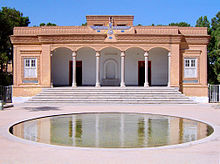Religion in Iran
Religion in Iran has been shaped by multiple religions and sects over the course of the country's history. Zoroastrianism was the main religion during the Achaemenid Empire (550–330 BC), the Parthian Empire (247 BC – 224 AD) and the Sasanian Empire (224–651 AD). In 651 AD, the Rashidun Caliphate conquered Persia and spread Islam as the main religion. Sunnism was the predominant form of Islam before the devastating Mongol conquest, but subsequently, Shi'ism became eventually utterly dominant in all of Iran with the advent of the Safavids.[1]
The current religious demographics of Iran are disputed.[2] According to the 2011 Iranian census, 99.98% of Iranians believe in Islam, while the rest of the population believe in other officially recognized minority religions: Christianity, Judaism, and Zoroastrianism.[3] However, because irreligion and some other religions are not recognized by the Iranian government and apostasy from Islam may be subject to capital punishment, government figures may be distorted.[2] A 2020 survey by the World Values Survey found that 96.6% of Iranians believe in Islam.[4] On the other hand, another 2020 survey conducted online by an organization based outside of Iran found a much smaller percentage of Iranians identifying as Muslim (32.2% as Shia, 5.0% as Sunni, and 3.2% as Sufi), and a significant fraction not identifying with any organized religion (22.2% identifying as "None," and some others identifying as atheists, spiritual, agnostics, and secular humanists).[5][6][7][8][9]
According to the CIA World Factbook, around 90–95% of Iranian Muslims associate themselves with the Shia branch of Islam, the official state religion, and about 5–10% with the Sunni and Sufi branches of Islam.[10] Christianity, Judaism and Zoroastrianism are officially recognized and protected, and have reserved seats in the Iranian parliament.[11] Iran is home to the second largest Jewish community in the Muslim world and the Middle East.[12] The two largest non-Muslim religious minorities in Iran are the followers of the Baháʼí Faith and Christianity.[13] The Baháʼí community, historically the largest religious minority group in Iran,[14] has been persecuted during its existence in Iran.[15][16][17][18]
History[]
Prehistory[]
The first known religious traditions in Iran traditions developed over time into Zoroastrianism.[citation needed]
Zoroastrianism[]

The written Zoroastrian holy book, called the Avesta, dates back to between 600 and 1000 BC, but the traditions it is based on are more ancient.[19] It was the predominant religion in the region until conquered Persia.
Zoroastrians in Iran have had a long history reaching back thousands of years, and are the oldest religious community of Iran that has survived to the present day. Prior to the Muslim Arab invasion of Persia (Iran), Zoroastrianism had been the primary religion of Iranian people. Zoroastrians mainly are ethnic Persians and are concentrated in the cities of Tehran, Kerman, and Yazd. The Islamic Republic government estimates the number of Zoroastrians is 20,000, Zoroastrian groups in Iran say their number is approximately 60,000.[20] According to the Iranian census data from 2011 the number of Zoroastrians in Iran was 25,271.[21]
This oppression has led to a massive diaspora community across the world, in particular, the Parsis of India, who number significantly higher than the Zoroastrians in Iran.
Mithra (Avestan: